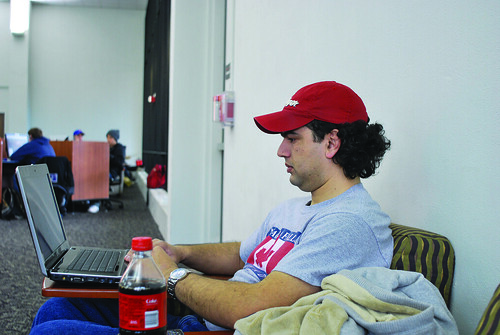Temple may be one of the “most connected” campuses in the nation with its Wi-Fi network, but this doesn’t mean students can get a wireless signal everywhere on campus.

Freshman psychology major Ryan Plotcher said the difference in getting a signal for his laptop varies depending on his location.
“I have one class in Anderson where I get a great signal, but in one of my classes down the hall, I get nothing,” Plotcher said.
With the exception of the University Services Building, nearly every building on campus has some level of Wi-Fi.
“We have probably close to 90 percent of common areas covered,” said David Lowe, assistant director of Network Services. “What I mean by that is the TECH Center, in a student lounge somewhere, you are going to have a wireless signal.”
Many of the lobbies in academic buildings have wireless signals. The outdoor locations on campus also pick up Wi-Fi signals. Temple’s other campuses also have Wi-Fi presences.
Not all the buildings on Main Campus receive Wi-Fi signals because most of the administrative offices do not have them available except in conference rooms. In residence halls, Wi-Fi can only be obtained in student lounges or other common rooms. Students have Internet access via Ethernet cables in their rooms.
The decision to keep residence halls wired was made before Wi-Fi technology came to campus mainly for financial and convenience reasons.
“We know wireless is easy. However, it is not as hooked up as wired, so actually, it is more of a service that we are providing to the students,” Lowe said.
There is a variety of Wi-Fi networks provided when students access the Internet from their laptops. Among those listed are the university’s Wifi4Owls network, Wireless Philadelphia and other non-Temple affiliates.
“Sometimes it is confusing because six of them come up,” said Matt Kern, a sophomore film and media arts major. “There’s Wifi4Owls, TUSecure, and then there is Pay4Owls.”
Some of these networks are not accessible to students because they may be in various stages of development or they are in the process of being phased out. The Wireless4Owls network was the original Wi-Fi network on campus that required students to go through several steps to get to the wireless network, such as MAC address registration, WEP key insertion and configuring a proxy server.
Wireless4Owls is being phased out in favor of WiFi4Owls, a network developed last year that allows students to connect to the Internet using their Accessnet usernames and passwords.
Currently, Network Services is migrating users off Wireless4Owls so the network can be completely phased out. There is also a new wireless network coming out called TUSecureWireless that is visible on Wi-Fi network listings but isn’t available for use. TUSecureWireless will allow students to access more restricted resources they normally would not be able to get to on WiFi4Owls.
Lowe said the network is set to debut soon, and the Department of Telecommunications is currently planning its announcement of the new network.
“I am just happy there is Wi-Fi here, and you can get on the Internet without a hard line,” Kern said. “It usually works pretty well, so that is a good thing.”
Brian Dzenis can be reached at brian.dzenis@temple.edu.



Be the first to comment